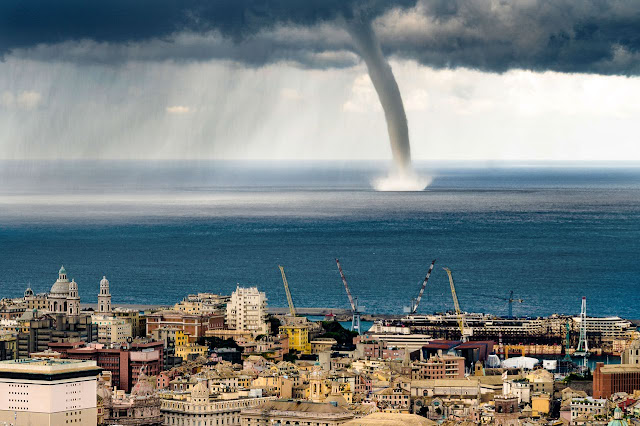A waterspout is an intense columnar vortex (usually appearing as a funnel-shaped cloud) that occurs over a body of water, connected to a cumuliform cloud. In the common form, it is a non-supercell tornado over water. While it is often weaker than most of its land counterparts, stronger versions spawned by mesocyclones do occur. Waterspouts do not suck up water; the water seen in the main funnel cloud is actually water droplets formed by condensation. Waterspouts have a five-part life cycle: formation of a dark spot on the water surface, spiral pattern on the water surface, formation of a spray ring, development of the visible condensation funnel, and ultimately decay.
Waterspouts exist on a microscale, where their environment is less than two kilometers in width. The cloud from which they develop can be as innocuous as a moderate cumulus, or as great as a supercell. While some waterspouts are strong and tornadic in nature, most are much weaker and caused by different atmospheric dynamics. They normally develop in moisture-laden environments as their parent clouds are in the process of development, and it is theorized they spin as they move up the surface boundary from the horizontal shear near the surface, and then stretch upwards to the cloud once the low level shear vortex aligns with a developing cumulus cloud or thunderstorm. Weak tornadoes, known as landspouts, have been shown to develop in a similar manner. More than one waterspout can occur in the same vicinity at the same time. As many as nine simultaneous waterspouts have been reported on Lake Michigan.
- Non-tornadic -
Waterspouts that are not associated with a rotating updraft of a supercell thunderstorm are known as "non-tornadic" or "fair-weather waterspouts", and are by far the most common type. Fair-weather waterspouts occur in coastal waters and are associated with dark, flat-bottomed, developing convective cumulus towers. Waterspouts of this type rapidly develop and dissipate, having life cycles shorter than 20 minutes. They are most frequently seen in tropical and sub-tropical climates. They typically move slowly, if at all, since the cloud they are attached to is horizontally static, being formed by vertical convective action instead of the subduction/adduction interaction between colliding fronts.Fair-weather waterspouts are very similar in both appearance and mechanics to landspouts, and largely behave as such if they move ashore.
- Tornadic -
Tornadic waterspouts, also accurately referred to as "tornadoes over water", are formed from mesocyclonic action in a manner essentially identical to traditional land-based tornadoes in connection with severe thunderstorms, but simply occurring over water. A tornado which travels from land to a body of water would also be considered a tornadic waterspout.
- Snowspout -
A winter waterspout, also known as a snow devil, an icespout, an ice devil, a snonado, or a snowspout, is an extremely rare instance of a waterspout forming under the base of a snow squall. The term "winter waterspout" is used to differentiate between the common warm season waterspout and this rare winter season event. Very cold temperatures need to be present over a body of water warm enough to produce fog resembling steam above the water's surface. Like the more efficient lake-effect snow events, winds focusing down the axis of long lakes enhance wind convergence and likely enhance their development.












No comments:
Post a Comment